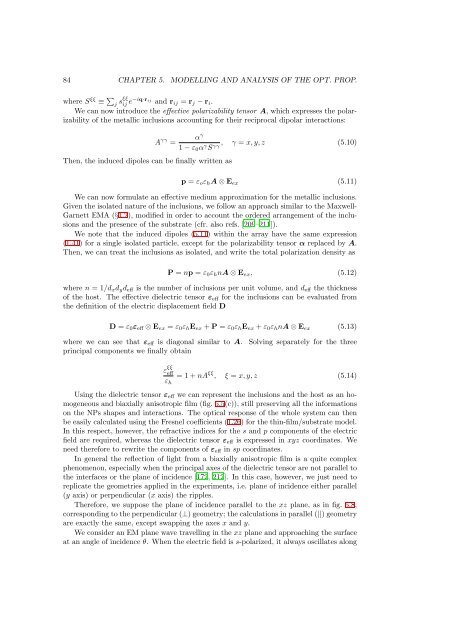Morphology and plasmonic properties of self-organized arrays of ...
Morphology and plasmonic properties of self-organized arrays of ...
Morphology and plasmonic properties of self-organized arrays of ...
Create successful ePaper yourself
Turn your PDF publications into a flip-book with our unique Google optimized e-Paper software.
84 CHAPTER 5. MODELLING AND ANALYSIS OF THE OPT. PROP.where S ξξ ≡ ∑ j sξξ ij e−iq·rij <strong>and</strong> r ij = r j −r i .We can now introduce the effective polarizability tensor A, which expresses the polarizability<strong>of</strong> the metallic inclusions accounting for their reciprocal dipolar interactions:A γγ =Then, the induced dipoles can be finally written asα γ1−ε 0 α γ Sγγ, γ = x,y,z (5.10)p = ε o ε h A⊗E ex (5.11)We can now formulate an effective medium approximation for the metallic inclusions.Given the isolated nature <strong>of</strong> the inclusions, we follow an approach similar to the Maxwell-Garnett EMA (§1.2), modified in order to account the ordered arrangement <strong>of</strong> the inclusions<strong>and</strong> the presence <strong>of</strong> the substrate (cfr. also refs. [209–211]).We note that the induced dipoles (5.11) within the array have the same expression(1.41) for a single isolated particle, except for the polarizability tensor α replaced by A.Then, we can treat the inclusions as isolated, <strong>and</strong> write the total polarization density asP = np = ε 0 ε h nA⊗E ex , (5.12)where n = 1/d x d y d eff is the number <strong>of</strong> inclusions per unit volume, <strong>and</strong> d eff the thickness<strong>of</strong> the host. The effective dielectric tensor ε eff for the inclusions can be evaluated fromthe definition <strong>of</strong> the electric displacement field DD = ε 0 ε eff ⊗E ex = ε 0 ε h E ex +P = ε 0 ε h E ex +ε 0 ε h nA⊗E ex (5.13)where we can see that ε eff is diagonal similar to A. Solving separately for the threeprincipal components we finally obtainε ξξeffε h= 1+nA ξξ , ξ = x,y,z (5.14)Using the dielectric tensor ε eff we can represent the inclusions <strong>and</strong> the host as an homogeneous<strong>and</strong> biaxially anisotropic film (fig. 5.5(c)), still preserving all the informationson the NPs shapes <strong>and</strong> interactions. The optical response <strong>of</strong> the whole system can thenbe easily calculated using the Fresnel coefficients (1.26) for the thin-film/substrate model.In this respect, however, the refractive indices for the s <strong>and</strong> p components <strong>of</strong> the electricfield are required, whereas the dielectric tensor ε eff is expressed in xyz coordinates. Weneed therefore to rewrite the components <strong>of</strong> ε eff in sp coordinates.In general the reflection <strong>of</strong> light from a biaxially anisotropic film is a quite complexphenomenon, especially when the principal axes <strong>of</strong> the dielectric tensor are not parallel tothe interfaces or the plane <strong>of</strong> incidence [172, 212]. In this case, however, we just need toreplicate the geometries applied in the experiments, i.e. plane <strong>of</strong> incidence either parallel(y axis) or perpendicular (x axis) the ripples.Therefore, we suppose the plane <strong>of</strong> incidence parallel to the xz plane, as in fig. 5.8,correspondingtotheperpendicular(⊥)geometry; thecalculationsinparallel(||)geometryare exactly the same, except swapping the axes x <strong>and</strong> y.We consider an EM plane wave travelling in the xz plane <strong>and</strong> approaching the surfaceat an angle <strong>of</strong> incidence θ. When the electric field is s-polarized, it always oscillates along
















